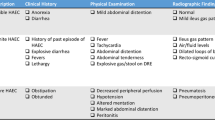Abstract
Purpose
It has been postulated that children with Hirschsprung disease (HD) and mucosal eosinophilia have been thought to have poorer outcome, but supporting evidence is lacking. The objective of our study was to review the outcomes of children with HD and mucosal eosinophilia.
Methods
A single center, retrospective review was conducted on all patients diagnosed with HD between 1999 and 2016. Pathology specimens were evaluated for mucosal eosinophilia. Demographics, complications, and outcomes were analyzed.
Results
A total of 100 patients were diagnosed with HD and 27 had mucosal eosinophilia. Median age at the time of surgery was 12 days (8, 30) and 82 were males. Comparing patients with HD with and without mucosal eosinophilia, there was no statistically significant difference in time to bowel function (2 days vs. 2 days; p = 0.85), time to start feeds (3 days vs. 3 days; p = 0.78) and time to goal feeds (5 days vs. 5 days; p = 0.47). There was no statistically significant difference in feeding issues (13% vs. 9%; p = 1.0) and stooling issues (60% vs. 50%; p = 0.38). There was no statistically significant difference in postoperative complications and readmissions rates (63% vs. 56%; p = 0.53).
Conclusion
Hirschsprung-associated mucosal eosinophilia may not increase postoperative complications, and may not change feeding and bowel management. Further prospective studies are in process to evaluate long term follow-up outcomes for this patient population.


Similar content being viewed by others
References
Langer JC (2013) Hirschsprung disease. Curr Opin Pediatr 25:368–374. https://doi.org/10.1097/MOP.0b013e328360c2a0
Best KE, Addor MC, Arriola L et al (2014) Hirschsprung’s disease prevalence in Europe: a register based study. Birth Defects Res Clin Mol Teratol 100:695–702. https://doi.org/10.1002/bdra.23269
Langer JC, Rollins MD, Levitt M et al (2017) Guidelines for the management of postoperative obstructive symptoms in children with Hirschsprung disease. Pediatr Surg Int 33:523–526. https://doi.org/10.1007/s00383-017-4066-7
Gosain A, Frykman PK, Cowles RA et al (2017) Guidelines for the diagnosis and management of Hirschsprung-associated enterocolitis. Pediatr Surg Int 33:517–521. https://doi.org/10.1007/s00383-017-4065-8
Levitt MA, Dickie B, Pena A (2012) The Hirschsprungs patient who is soiling after what was considered a “successful” pull-through. Semin Pediatr Surg 21:344–353. https://doi.org/10.1053/j.sempedsurg.2012.07.009
Onishi S, Nakame K, Kaji T et al (2017) The bowel function and quality of life of Hirschsprung disease patients who have reached 18 years of age or older—the long-term outcomes after undergoing the transabdominal soave procedure. J Pediatr Surg 52:2001–2005. https://doi.org/10.1016/j.jpedsurg.2017.08.036
Neuvonen MI, Kyrklund K, Rintala RJ, Pakarinen MP (2017) Bowel function and quality of life after transanal endorectal pull-through for Hirschsprung disease: controlled outcomes up to adulthood. Ann Surg 265:622–629. https://doi.org/10.1097/SLA.0000000000001695
Jensen ET, Martin CF, Kappelman MD, Dellon ES (2016) Prevalence of eosinophilic gastritis, gastroenteritis, and colitis: estimates from a national administrative database. J Pediatr Gastroenterol Nutr 62:36–42. https://doi.org/10.1097/mpg.0000000000000865
Choi JS, Choi SJ, Lee KJ et al (2015) Clinical manifestations and treatment outcomes of eosinophilic gastroenteritis in children. Pediatr Gastroenterol Hepatol Nutr 18:253–260. https://doi.org/10.5223/pghn.2015.18.4.253
Behjati S, Zilbauer M, Heuschkel R et al (2009) Defining eosinophilic colitis in children: insights from a retrospective case series. J Pediatr Gastroenterol Nutr 49:208–215. https://doi.org/10.1097/MPG.0b013e31818de373
Furuta GT, Katzka DA (2015) Eosinophilic esophagitis. N Engl J Med 373:1640–1648. https://doi.org/10.1056/NEJMra1502863
Pacilli M, Eaton S, Clarke A et al (2012) Clinical significance of eosinophilia and chronic inflammatory infiltrate in children’s rectal biopsies. J Pediatr Gastroenterol Nutr 55:519–522. https://doi.org/10.1097/MPG.0b013e31825b3169
Lowichik A, Weinberg AG (1997) Eosinophilic infiltration of the enteric neural plexuses in Hirschsprung’s disease. Pediatr Pathol Lab Med 17:885–891
Towne BH, Stocker JT, Thompson HE, Chang JH (1979) Acquired aganglionosis. J Pediatr Surg 14:688–690
Spergel JM, Book WM, Mays E et al (2011) Variation in prevalence, diagnostic criteria, and initial management options for eosinophilic gastrointestinal diseases in the United States. J Pediatr Gastroenterol Nutr 52:300–306. https://doi.org/10.1097/MPG.0b013e3181eb5a9f
Schäppi MG, Smith VV, Milla PJ, Lindley KJ (2003) Eosinophilic myenteric ganglionitis is associated with functional intestinal obstruction. Gut 52:752–755
Juang D, Snyder CL (2012) Neonatal bowel obstruction. Surg Clin N Am 92:685–711. https://doi.org/10.1016/j.suc.2012.03.008
Author information
Authors and Affiliations
Corresponding author
Ethics declarations
Conflict of interest
All authors declare that they have no conflict of interest.
Ethical approval
This article does not contain any studies with human participants or animals performed by any of the authors.
Rights and permissions
About this article
Cite this article
Sola, R., Poola, A.S., Memon, R. et al. The relationship of eosinophilia with outcomes of Hirschsprung disease in children. Pediatr Surg Int 35, 425–429 (2019). https://doi.org/10.1007/s00383-018-04430-9
Accepted:
Published:
Issue Date:
DOI: https://doi.org/10.1007/s00383-018-04430-9




